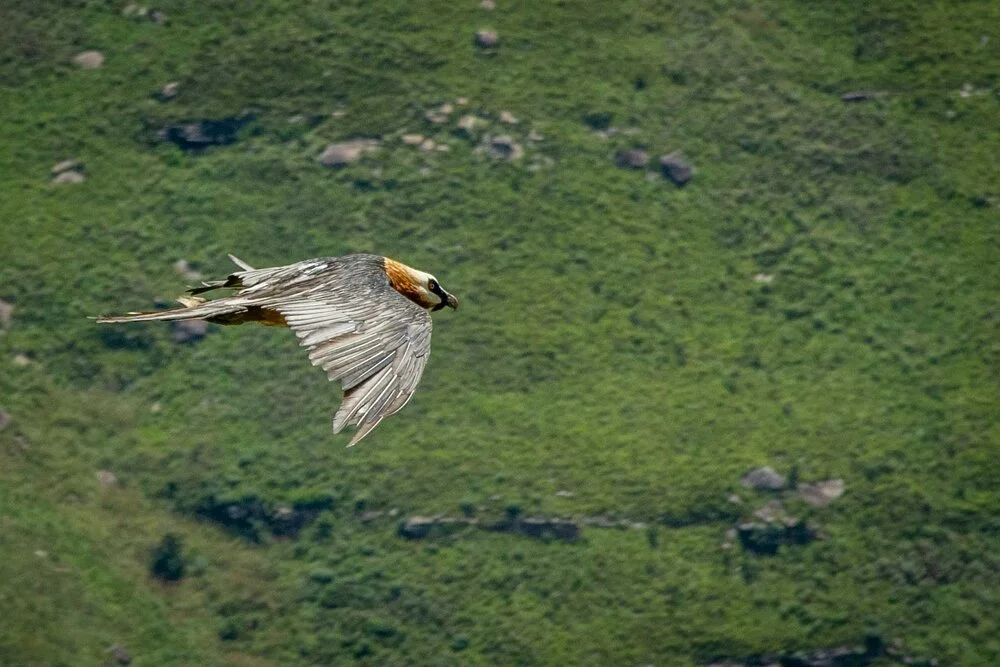Why we love Lammergeiers
We’re hiking to help the badass Bearded vulture.
Lammergeier 🦅
It's not the prettiest translation, but the critically endangered Bearded vulture is also known as a 'Lamb Vulture'. Perhaps it should be known as the LammerGOOIER because it occupies a super niche space in the weird and wonderful world of vulture scavenging.
No, It doesn't throw lambs.
Instead of competing with other vultures at a fresh carcass, this bird will forage over vast distances (up to 700km in one day has been recorded) to find older carrion. As much as 85% of its diet consists of mere bones! 🦴 The Bearded vulture gets most of its nutrition from the marrow inside by dropping these bones from extraordinary heights to crack open the bones using hard rock.
Vultures are vital
Vultures provide crucial ecosystem services in our environment. Their effect is grossly underestimated and sadly goes largely under-appreciated.
These fascinating scavengers are not only remarkably efficient at disposing of rotting carcasses, but they reduce the spread of disease among wildlife, livestock and across to humans too. They play a critical role in protecting us from the ever-increasing global risk of disease transmission.
Vultures face plenty of threats because they can fly long distances. Thy suffer from direct and indirect poisoning, electrocutions and collisions with energy infrastructure, plus habitat loss and disturbance along with food shortages.
For every trip we take, we partner with a relevant organisation that does some good in the immediate area. For our Giant's Cup Trail, we want to highlight the plight of these incredible birds since we'll be sharing their remote, mountainous terrain.
We will be walking through a World Heritage Site in KwaZulu-Natal and one of the last strongholds for this endangered species.
How does Wildlife Act help vultures?
It's estimated that just 50 to 100 breeding pairs remain in South Africa and Lesotho.
The Southern Drakensberg Conservation Project is heavily focused on vulture conservation and Wildlife Act is closely monitoring vultures in the Maloti-Drakensberg Park. Our donation from this trip will go towards their work on the ground.
Wildlife Act works closely with partners such as Ezemvelo KZN Wildlife, The Endangered Wildlife Trust, BirdLife SA and the National Department of Environment, Forestry and Fisheries to help protect vultures in South Africa.
Fine-scale vulture monitoring has allowed accurate identification of “vulture hotspots” to ensure that these areas benefit the most from collective conservation energy and mitigation measures.
Annual nest surveys are carried out to monitor breeding success and long-term trends to measure the health of our current vulture populations.
A dedicated fund for emergency response (to poisoning events or decontamination) enables an effective rapid response team of technically trained staff with the appropriate equipment.
I love vultures too! How can I help?
See a vulture on your hike? Record the identification number and species (if possible) along with the GPS (or physical) location. Try to get a picture too. You can submit your sightings to Project Vulture.
Donate to the Zululand Vulture Project.
Volunteer for the vulture monitoring in the Southern Drakensberg. Volunteers hike into mountainous areas to identify and monitor activity at the nesting sites during the active breeding months, from May to November. A week costs R4200 per person for SADC citizens.
If you don't have one yet, apply for a MySchool MyVillage MyPlanet card. You can add Wildlife ACT as a beneficiary via the MySchool website and get swiping.
Spread awareness about vulture conservation. Vultures sadly have a slot the Ugly Five list and are commonly viewed as announcers of death or fearsome creatures ready to reap decaying flesh. African Vulture populations are experiencing rapid declines, they could use all the good press they can get!


